Your machine's warranty has expired. Think of it like a ship ending its stay in a safe harbor, about to sail alone into a vast, unpredictable sea. You're rightfully concerned about sudden breakdowns, as unexpected downtime and expensive emergency repairs can shatter your production schedule and directly harm your profits.
The best strategy is to shift from reactive repair to proactive maintenance. After the warranty, you must systematically inspect and replace key "wear and tear" components like SMC and Parker pneumatic valves, FESTO cylinders, heating lamps, and servo motors. This ensures your Ribo 6-cavity machine runs smoothly and efficiently, protecting you from the costly surprises that eat away at your bottom line.
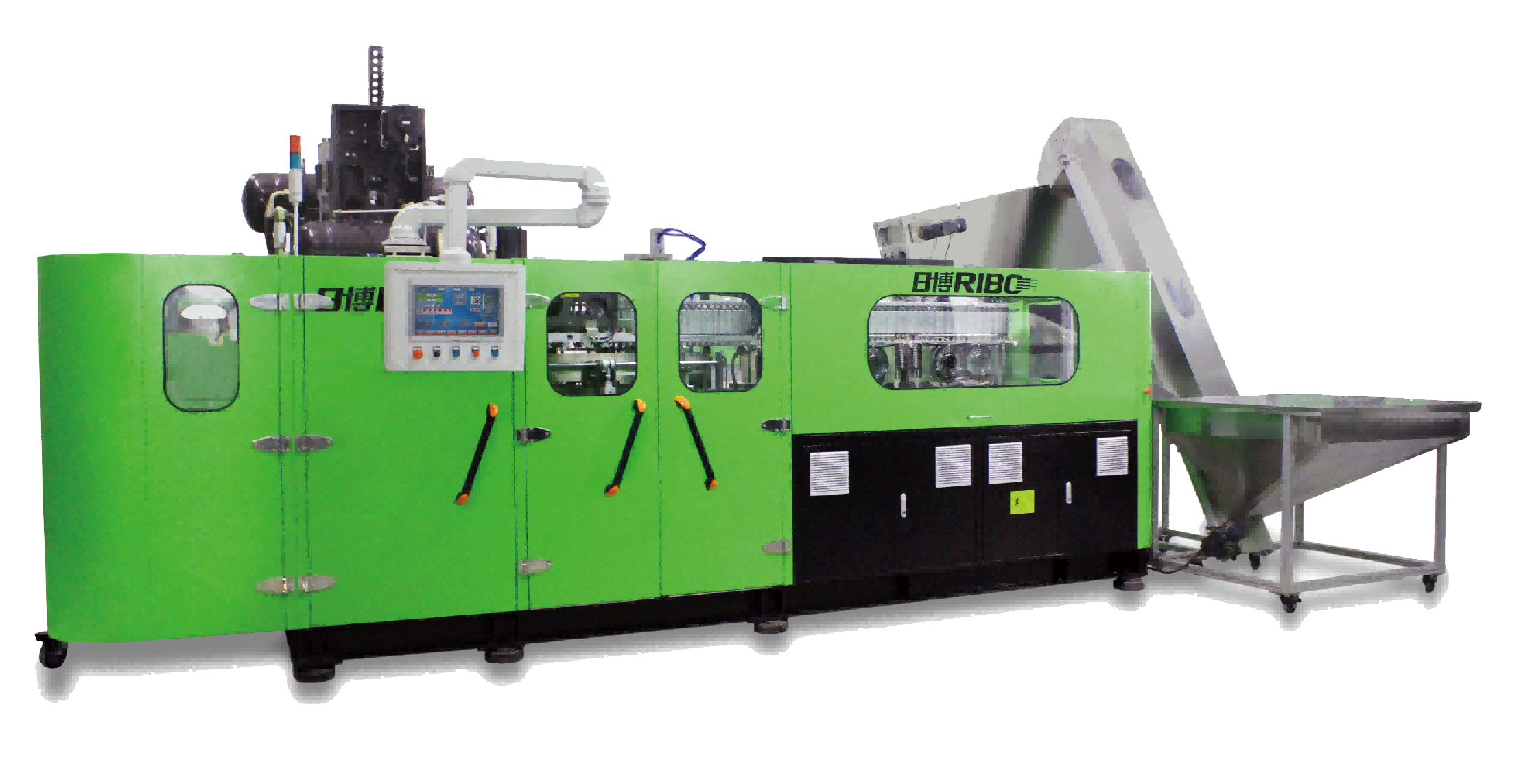
I've learned this lesson through years of hands-on experience. Many of my clients only call me in a panic when their machine is already down. A great example is a client of mine in Malaysia who runs a Ribo 6-cavity machine. I had manufactured their high-quality blow bottle mold, which is how we built our relationship. During one conversation, he complained about persistent air leaks, an unresponsive touch screen, and uneven bottle heating. After a deep dive, I was shocked to learn their machine had been running continuously for over three years with no systematic maintenance whatsoever. His factory was facing serious production delays. This real-world story is precisely why I wrote this guide. Ignoring routine checks on your bottle blowing machine is a high-stakes gamble you can't afford to lose. Let's explore the critical parts you must watch.
Why Do SMC Low-Pressure Control Valves Slow Down After High-Frequency Use?
Your machine is running, but you have a nagging feeling the cycle time has crept up. That half-second delay, caused by a slow-acting valve, quickly accumulates into a massive loss of output and efficiency over a shift.
These valves are the nervous system for low-pressure actions. After millions of cycles, their internal seals harden from contaminants in the air line, and friction increases. This degradation slows their response time, creating a bottleneck for your entire production rhythm. Proactive replacement is the key to maintaining peak efficiency.
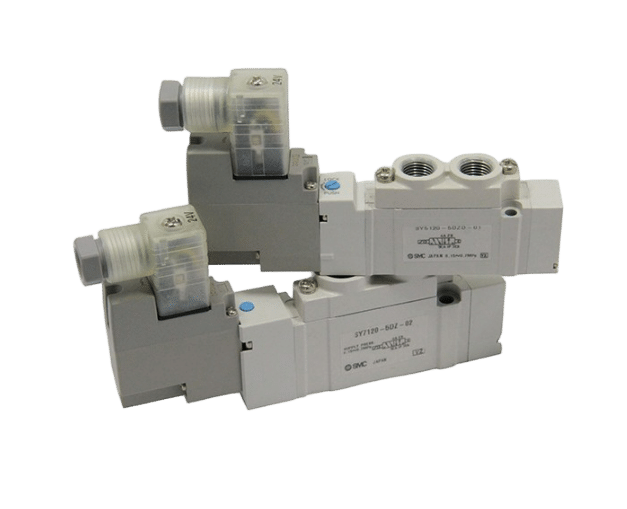
The SMC low-pressure control valves, often 5/2-way or 5/3-way models from the popular SMC SY series, are high-precision components. They translate electrical signals into pneumatic action, driving the grippers, stretch rods, and preform flipping mechanisms. The speed of these seemingly minor actions directly dictates your machine's Bottles Per Minute (BPM).
The Deeper Causes of Failure:
- Seal Contamination and Hardening: Compressed air is never perfectly clean. It contains water vapor, oil mist, and tiny dust particles. These contaminants stick to the valve's internal seals (usually NBR rubber), causing them to harden and lose elasticity. This increases the friction the valve spool has to overcome, slowing it down and leading to sticking or "stiction."
- Solenoid Coil Fatigue: Every time the valve actuates, the solenoid coil heats up. Over millions of cycles, this thermal stress degrades the coil's insulation and can slightly weaken its magnetic force. A weaker coil has less power to shift the spool, resulting in a delayed response.
- Loss of Internal Lubrication: The valves are lubricated at the factory. This grease wears away or gets washed out by contaminants over time, leading to direct metal-on-metal friction and accelerated wear.
I advise clients to include SMC valve checks in their daily inspections. An operator can listen for hissing sounds, a clear sign of a leak. A more advanced check is to inspect the upstream Air Filter-Regulator-Lubricator (FRL) unit. Ensure the filter is draining water and the lubricator (if used) is working. Every 1.5 to 2 years, even if the valves seem to be working, a full replacement is a wise investment. This small cost prevents a major failure, like a stuck gripper causing a collision with the mold, which would result in a far more expensive repair.
Do Parker High-Pressure Solenoid Valve Sets Cause Internal Leakage?
You're seeing a quiet increase in rejected bottles. The defects are subtle: tiny bubbles in the bottle wall, an off-center gate at the base, or inconsistent wall thickness. You've tweaked the process parameters endlessly, but the problem persists, strongly suggesting an issue at the pressure source.
Yes, absolutely. The Parker high-pressure valve set is the heart of the blowing system. Over time, its main seals degrade under the relentless assault of high-pressure air, causing hidden internal leaks. This leakage makes the blowing pressure unstable, which is a primary cause of bottle molding defects.
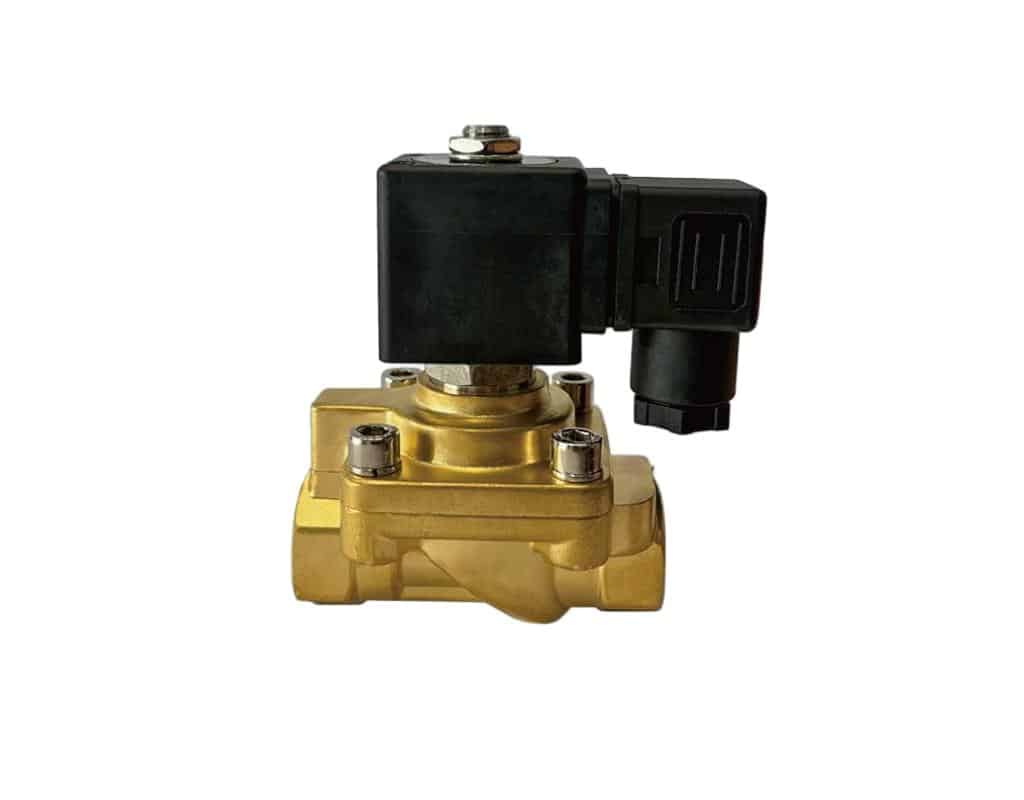
This valve assembly from a top brand like Parker is a marvel of engineering. It must precisely control the timing and volume of air at pressures up to 40 Bar (580 PSI) in milliseconds. It manages both the initial "pre-blow" phase (which stretches the preform) and the final "high-blow" phase (which forms the bottle against the mold). Any leak or delay ruins this delicate process. My Malaysian client's issue with deformed bottles was a textbook case of unstable high-pressure. We diagnosed it by listening: the valve's action was a dull "thud" instead of a crisp "bang," and we could feel a faint, constant airflow from the exhaust port—a dead giveaway of an internal leak.
Diagnostic and Maintenance Tips:
- Listen to the Sound: A healthy high-pressure valve makes a sharp, powerful "bang" when it fires. A muffled sound or a "hiss" indicates pressure loss and slow action.
- Check the Exhaust Port: During the cycle, carefully check the valve's exhaust silencer. If you feel a steady stream of air leaking out even when the valve is supposed to be closed, you have confirmed an internal leak.
- Monitor Bottle Weight: Inconsistent pressure often leads to inconsistent material distribution and, therefore, inconsistent bottle weight. If you have a precision scale, regularly weighing your bottles can be an excellent quality control check. An increase in weight variance should put the high-pressure valve on your suspect list.
I strongly recommend replacing the entire valve set every two years. If budget is a major concern, at least order an original manufacturer's seal kit and have it installed by a technician after 18 months of operation. A stable and reliable blowing process is the most fundamental way to protect your investment in a high-quality blow bottle mold.
Are FESTO Flip Cylinders Prone to Wear?
The preform transfer from the heating oven to the mold is no longer a smooth, swift motion. You notice a slight hesitation or wobble, and occasionally a preform is dropped, jamming the line and forcing a shutdown.
Yes, wear on the FESTO flip cylinder is inevitable due to its high-frequency operation. The wear points extend beyond simple seals to include its internal guide rods and bearings. This wear accumulates into positioning errors, leading to imprecise movements and a cascade of downstream problems.

This transfer mechanism, often a guided cylinder or rotary actuator from a premium brand like FESTO, has a mission-critical task. It must transfer a soft, hot (over 100°C) preform and place it perfectly in the center of the mold cavity, all within a fraction of a second.
A Deeper Look at Wear:
- Guide Bushing and Rod Wear: The cylinder's piston rod is subjected to side loads from the weight of the transfer arm. Over millions of cycles, this wears down the guide bushings, creating a larger gap. This increased clearance results in a slight wobble at the end of the stroke, destroying positioning accuracy.
- Improper Cushioning: Cylinders have adjustable air cushions at each end to decelerate the piston smoothly. If not adjusted correctly, or if the cushion seals are worn, the piston will slam into the end cap. This creates shock and vibration that accelerates mechanical wear and can even loosen other nearby components.
- Seal Failure: This is the most common issue, leading to air leaks. Leaks make the cylinder's movement weak, slow, or erratic.
To maximize its life, I advise clients to add "lubricate flip cylinder guide rods" to their weekly maintenance checklist. Using a compatible, high-temperature grease protects the surfaces from wear. After about 5,000 hours of operation, you should schedule a professional overhaul to replace all seals and check the guide clearance. If the wobble is significant, the entire cylinder should be replaced. Ignoring this component can have serious consequences: a dropped hot preform can melt onto the machine frame or fall into the mechanics below, creating a fire hazard and causing expensive damage.
Should I Worry About Jinqi Clamping Cylinder Seals?
The machine's grippers seem to have a weak grip, frequently dropping preforms. You're finding more and more preforms on the floor, which not only wastes material but also causes frequent machine stops, killing your production continuity.
You absolutely should worry. The clamping cylinders are the first link in the reliable transfer of preforms. Their internal seals and cushion pads are highly susceptible to failure due to the combination of high-frequency impacts and radiated heat from the hot preforms. Once they fail, your clamping force becomes weak and inconsistent.
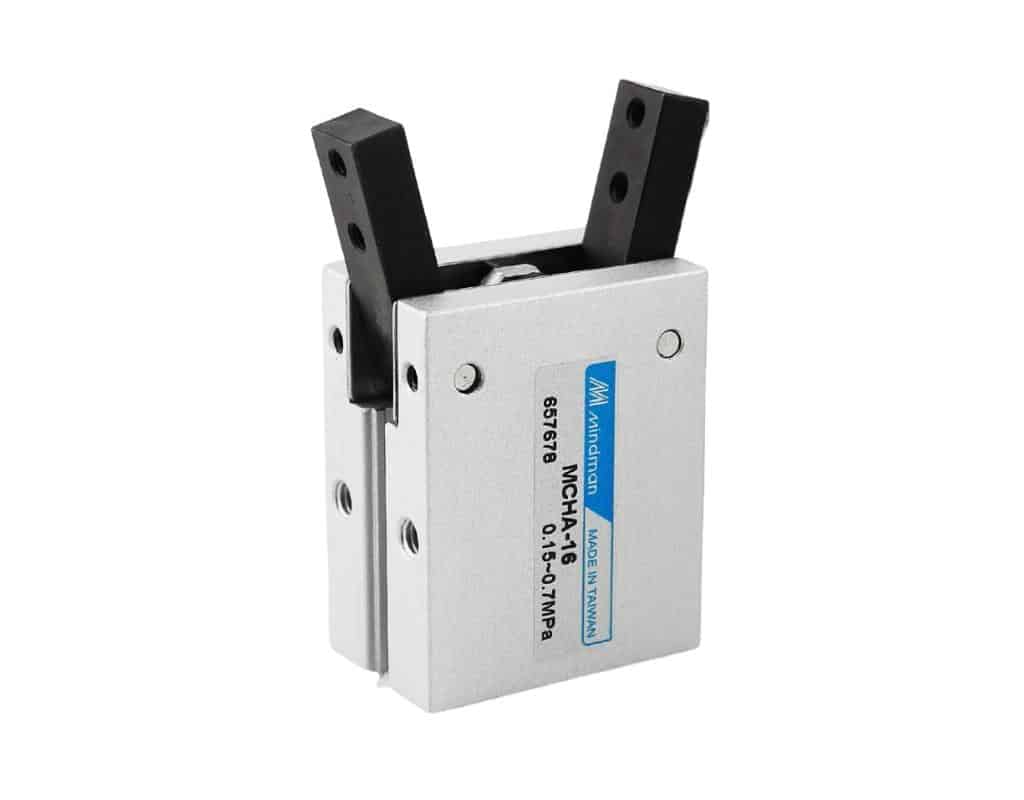
Jinqi clamping cylinders are workhorses, constantly opening and closing to grip and release preforms. This endless repetition puts immense stress on their internal parts, but it's the heat that is the real killer. The cylinder operates just inches away from preforms that have been heated to their softening point.
Failure Points Explored:
- Seal Brittleness: The heat radiated from the preforms accelerates the aging of the rubber piston seals. They lose their flexibility, become hard and brittle, and can no longer provide a perfect seal. This results in internal leaks and a significant loss of gripping force.
- Cushion Pad Disintegration: The small polyurethane or rubber pads that absorb the shock at the end of the stroke also suffer from the heat. They can harden and crack, and in worst-case scenarios, they can disintegrate. Small pieces can then travel through the air lines and jam up the control solenoid valves, creating a much more complex problem.
- Gripper Finger Wear: Beyond the cylinder itself, always inspect the metal or plastic "fingers" that physically touch the preform. Wear on these surfaces can also prevent a secure grip.
For any machine, I recommend a check-up of the clamping cylinders twice a year. This involves manually moving the grippers to feel for any looseness or rough spots. You can also use soapy water on the cylinder joints to spot any leaks while it's operating. This simple, preventative action is incredibly effective at preventing jams. A single dropped preform that gets caught in a closing mold can cause catastrophic damage to your very expensive blow bottle mold.
Troubleshooting Common Defects and Their Root Causes
| Bottle Defect | Direct Cause | Likely Root Component Failure |
|---|---|---|
| Deformed Wall / Bubbles | Unstable Blowing Pressure | Parker High-Pressure Valve internal leakage. |
| Uneven Wall Thickness | Non-uniform Preform Temp | Infrared Heating Lamp power decay or dirty reflectors. |
| Scratches on Bottle Body | Rough Mechanical Movement | Wear in FESTO Flip Cylinder or Jinqi Clamping Cylinder. |
| Off-Center Gate | Misalignment of Stretch Rod | Stretch rod seal issue or SMC valve actuation delay. |
Do Infrared Heating Lamps Lose Power Over Time?
You've noticed a steady increase in rejects due to uneven wall thickness. Your process technicians are constantly adjusting heating percentages, but they are fighting a losing battle to get a uniformly heated preform.
Yes, this is an unavoidable and irreversible process. After 3,000 to 4,000 hours of use, the effective energy output of standard infrared heating lamps drops significantly. This decay is gradual and invisible to the naked eye, but it is a silent killer of bottle quality, leading to poor stretching and material distribution.
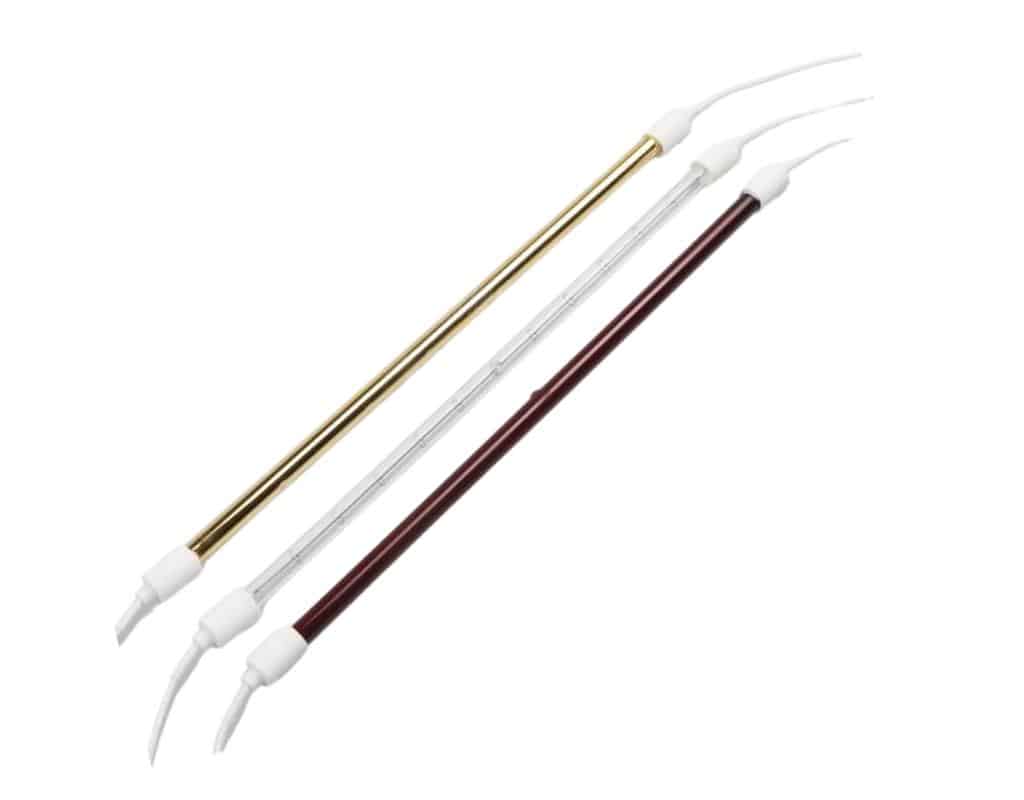
Heating is the soul of the PET blow molding process. The infrared lamps radiate energy into the preform, raising its temperature to the precise glass transition point where it can be stretched. The uniformity of this heating is paramount.
The Science of Decay:
- Tungsten Evaporation: The tungsten filament inside the lamp slowly evaporates at high temperatures. This tungsten vapor deposits on the inside of the quartz glass tube, creating a dark film that physically blocks infrared radiation, reducing the lamp's output.
- Infrared Spectrum Shift: As the filament ages, its operating temperature can change slightly. This can shift the spectrum of infrared energy it emits, moving it away from the peak absorption wavelength of PET material, thus reducing heating efficiency.
- Reflector Contamination: The polished aluminum reflectors behind the lamps are just as important as the lamps themselves. They can become coated with a fine film from plastic outgassing or airborne dust. An oxidized or dirty reflector scatters the infrared energy instead of focusing it on the preform, creating hot and cold spots.
A perfect bottle is born from the marriage of a well-designed preform mold and a precise heating profile. The mold dictates the starting material distribution, and the heating dictates how it can be stretched. I strongly recommend a group replacement of all heating lamps after 3,000-4,000 hours. Don't wait for them to burn out completely. At the same time, you must clean or, ideally, replace the reflectors. Cleaning them with isopropyl alcohol and a lint-free cloth can restore their performance, but replacement is best for optimal results.
What Does Noise from a Yaskawa Servo Motor Mean?
While walking the floor, you hear an unfamiliar noise coming from the machine during mold clamping or preform transfer—perhaps a high-pitched whine or a low, grinding rumble. You also notice the motion seems less crisp, almost hesitant.
Treat this as an immediate red flag. Any new noise or vibration from a high-precision servo motor like a Yaskawa is a serious warning of impending failure. It typically points to mechanical wear in the bearings or an electrical fault in the encoder. If ignored, it will almost certainly lead to a sudden, costly breakdown.
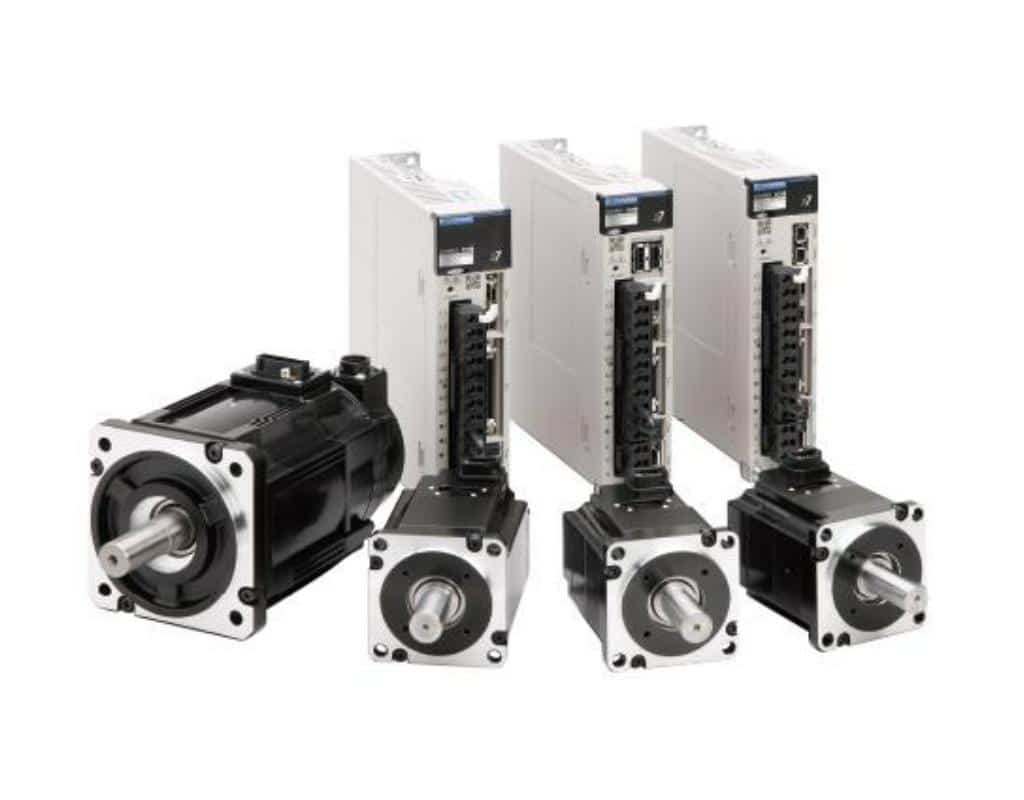
Servo motors from top-tier brands like Yaskawa are the powerful, precise muscles of your machine. On a Ribo machine, they often drive the mold's toggle clamp mechanism and the preform transfer chain. Their health is directly linked to the machine's stability and the safety of your mold.
Diagnosing Noises and Vibrations:
- Low Rumble or Grinding: This is almost always a mechanical issue, indicating that the motor's internal ball bearings are worn out and failing.
- High-Pitched Whine: This type of noise is often electrical. It can be caused by improper drive parameters or, more critically, be a symptom of a failing encoder.
- Jittery or Hesitant Motion: This is the most dangerous sign. The encoder is the motor's "eyes," constantly reporting its exact position back to the controller. If the encoder starts to fail, the controller loses its ability to accurately command the motor. This can cause it to "lose its position" or "overshoot" its target. In a mold-clamping operation, this is catastrophic and can easily damage the mold.
I recommend scheduling a professional servo system check every two years. This should include checking the drive belt tension, cleaning the motor's cooling fan, and performing diagnostic tests to evaluate bearing health. Also, inspect all power and encoder cables for wear and tear. When you hear a Yaskawa motor noise issue, your window for preventative action is very short. Act decisively.
Are Aging Touch Screens and PLCs a Real Risk?
The machine's Weinview touch screen has become sluggish, with certain areas becoming completely unresponsive "dead zones." You worry that one day you won't be able to adjust a critical setting. Worse, you've heard rumors that a PLC can lose its program.
This is not a rumor; it is a very real and devastating risk. After 3-4 years, the hardware of a Weinview HMI naturally degrades. But the more critical, hidden danger lies inside the Omron PLC: a small coin-cell battery that is the only thing protecting your machine's entire operating system from being wiped out.
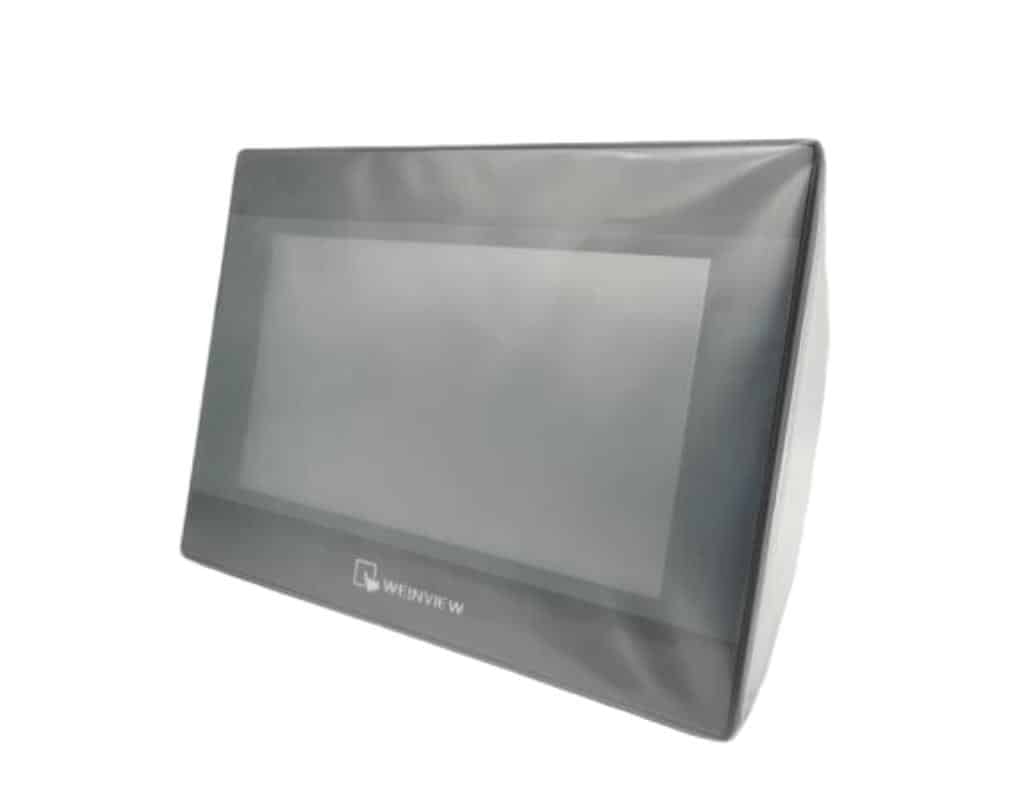
The HMI (Human-Machine Interface) and PLC (Programmable Logic Controller) are the brain and central nervous system of your bottle blowing machine.
Touch Screen Aging:
The Weinview screen's backlight has a finite life and will dim over time. Its resistive touch layer physically wears out from millions of taps, leading to calibration drift and dead zones. This was a key issue for my Malaysian client; adjusting a temperature setting became a frustrating, multi-tap ordeal, wasting precious time.
The PLC Battery Time Bomb:
The Omron PLC uses a small lithium battery to provide power to its SRAM (Static Random-Access Memory) when the machine's main power is off. This SRAM holds your two most valuable digital assets: the machine's ladder logic program and all of your finely-tuned production recipes. This battery's reliable lifespan is only 2-3 years. If the battery dies and your facility has a power outage—even for a second—the SRAM is wiped clean. Your machine becomes a "brick." All the recipes you've perfected are gone. The downtime until you can get a technician to reload and debug the program can be days or even weeks.
I implore all my clients to do two things immediately: First, contact your machine supplier and get a digital backup of your PLC's ladder logic program. Store it in multiple safe places. Second, make replacing the PLC battery a mandatory maintenance task every two years. It's a $5 part that protects a five-figure asset.
Why is a Custom Nylon Heating Link a Hidden Problem?
You've completed all the standard maintenance, but the machine still has an intermittent, hard-to-diagnose issue—perhaps a heating inconsistency or a strange mechanical noise. You and your team are frustrated, unable to find the source.
I suggest you inspect the small, black connectors that join the heating oven's tracks to the conveyor chain. These custom-molded parts, made of reinforced nylon, are often overlooked. Subjected to constant heat and mechanical stress, they become brittle and crack, making them a true "hidden failure point."
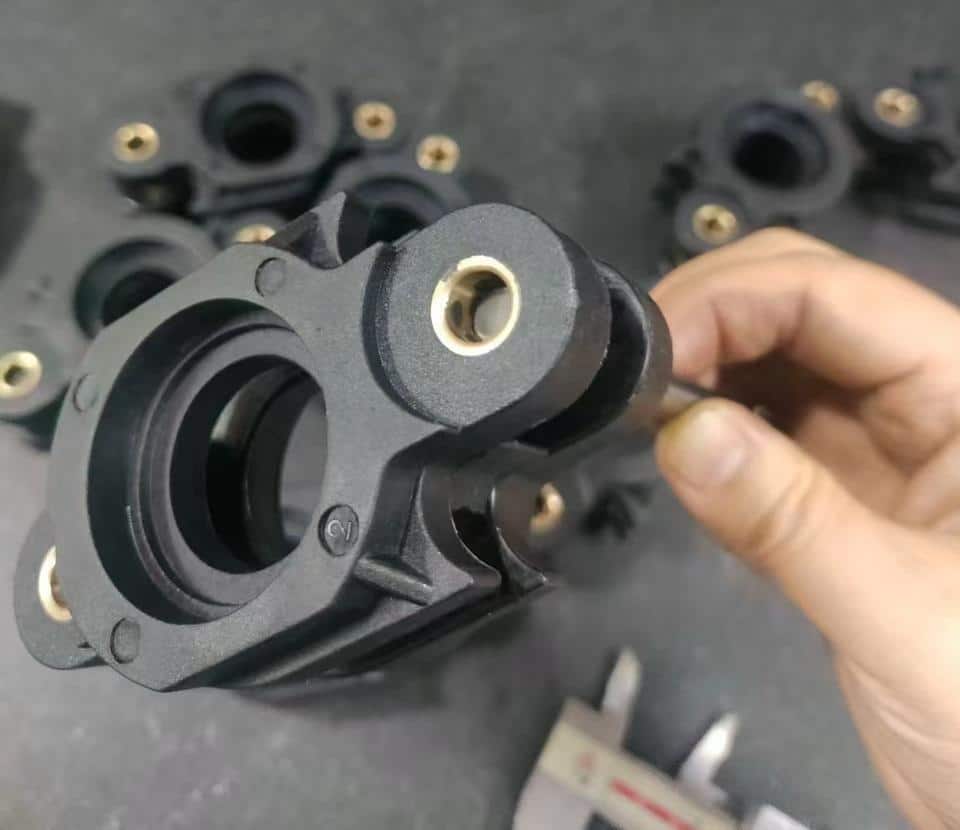
I have found this part to be the culprit in many "mystery" failures. This link connects the rail that the preform holders ride on to the drive chain. It lives in an incredibly harsh environment: baked by the infrared lamps from below while being pulled and twisted by the chain.
How It Fails:
- Material: It's typically made from a glass-fiber or carbon-fiber reinforced nylon (PA) to provide a balance of strength and heat resistance.
- Aging Process: The constant thermal cycling (heating up, cooling down) and mechanical vibration cause fatigue in the material's polymer structure. It becomes brittle, and micro-cracks begin to form, usually starting at a high-stress point like a corner or bolt hole.
- Why It's Missed: It's not an electronic or a major pneumatic part, so it doesn't appear on standard maintenance checklists. It's often hidden by guards, out of sight and out of mind.
When this link finally fails, the consequences can range from minor to severe. A crack could cause a section of the rail to sag, leading to uneven heating. A complete fracture could cause the rail to misalign and jam the entire oven, or worse, fall into the machine. Because it is a non-standard, custom part, getting a replacement can take a long time. Therefore, when you buy blow molding spare parts China, I highly recommend adding a set of these links to your order to keep on hand. Make it a mandatory part of your annual inspection to check every single one for cracks or looseness.
Comprehensive Maintenance Strategy Summary
| Core Component | Inspection Frequency | Replacement Guideline | Key Actions |
|---|---|---|---|
| SMC Low-Pressure Valves | 8-12 Months | 1.5–2 Years | Listen for leaks, check FRL unit, proactive replacement. |
| Parker High-Pressure Valve | 12 Months | 2 Years (or 1.5Y seal kit) | Listen to sound, check exhaust port, monitor bottle weight. |
| FESTO Flip Cylinder | 6 Months | 5000 Hours (seals) | Lubricate guide rods, check cushioning, assess for wobble. |
| Heating Lamps | 3000 Hours | 3000–4000 Hours | Group replacement with reflectors, clean surfaces. |
| Yaskawa Servo Motor | 24 Months | Upon noise/vibration | Check belt tension, clean fan, schedule professional tests. |
| Omron PLC Battery | 24 Months | 2–3 Years | Mandatory replacement, maintain program backups. |
| Nylon Heating Link | 12 Months | On first sign of cracking | Annual inspection, keep spares on hand. |
Your Partner for a Smooth-Running Machine
Finding the right replacement parts can be a complex task, but my team and I are here to simplify it for you. Our company can supply all of the critical components discussed in this guide, from genuine SMC and Parker valves to the custom-molded nylon links. We guarantee the correct model and dimensions for your specific machine, taking the guesswork out of your maintenance and ensuring a perfect fit for reliable operation.
Conclusion
Remember, proactive maintenance is not an expense; it is the best investment you can make in your production uptime and profitability. Systematically checking and replacing these key parts on your Ribo machine builds a powerful defense against unexpected downtime, ultimately protecting your bottom line.
Frequently Asked Questions (FAQs)
1. Is it really cheaper to replace parts before they break?
Without a doubt. The cost of a planned replacement for a PLC battery or an SMC valve is predictable and minimal. The cost of an unplanned breakdown includes lost production, missed deadlines, premium charges for expedited parts, and emergency technician fees. Proactive maintenance is the classic definition of "an ounce of prevention is worth a pound of cure."
2. I'm not a trained technician. How can I perform these checks?
You can perform most of the "health checks" yourself. It's about using your senses: listen for new or unusual noises, look for quality changes in your bottles and hesitation in the machine's movements, and carefully feel for abnormal heat from motors or valves. For the more technical tasks, I recommend building a relationship with a trusted supplier or service technician who can perform an annual in-depth inspection and handle the complex replacements.
3. Where can I find the right spare parts for my Ribo machine?
Finding the correct PET blow mold repair parts can be a challenge. Some are standard components from global brands, but others, like the nylon link, are custom. Working with a supplier who deeply understands the specific build of your bottle blowing machine is crucial. We provide a one-stop solution for our clients, ensuring every part is correct and validated, saving you the headache of trial and error.
4. My machine isn't a Ribo. Does this advice still apply?
Yes, this guide is highly relevant. While it focuses on the Ribo 6-cavity, the underlying principles of wear and maintenance for the core systems (pneumatics, heating, servos, controls) are universal across most brands of linear PET blow molding machines. The specific part numbers will differ, but the failure modes and maintenance philosophy are the same. You can use this guide as a template to create a robust maintenance plan for your specific equipment.
5. How does a worn machine part affect my expensive blow mold?
This is an excellent question that highlights a critical connection many overlook. An unstable machine is a silent killer of tooling. For example, if a worn cylinder causes a preform to be misaligned by just a millimeter, the high-speed mold clamp can cause a collision, nicking or damaging the precision-machined surfaces of your blow bottle mold. An unstable blowing pressure might lead you to mistakenly think your mold is flawed and make incorrect adjustments. Keeping your machine healthy is the best way to protect your significant investment in tooling.
🔗 Learn More about Blow Molding Equipment and Maintenance Concepts
Blow Molding – Wikipedia
General overview of the blow molding process, relevant to understanding how parts like valves and cylinders function.Preventive Maintenance – Wikipedia
Covers the concept of replacing wear parts before failure — very applicable to post-warranty blow molding machines.Pneumatics – Wikipedia
Describes systems using compressed air — related to many key parts in blow molding machines like cylinders, valves, and solenoids.O-ring – Wikipedia
Common sealing element, often replaced in older or high-use machines — useful to mention as a typical wear part.Solenoid Valve – Wikipedia
Key component in air control systems, often needs replacement after long-term operation in blow molding equipment.
Share:
- Click to share on WhatsApp (Opens in new window) WhatsApp
- Click to share on Facebook (Opens in new window) Facebook
- Click to share on X (Opens in new window) X
- Click to share on LinkedIn (Opens in new window) LinkedIn
- Click to email a link to a friend (Opens in new window) Email
- Click to share on Tumblr (Opens in new window) Tumblr
